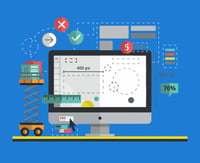
Virtual Reality (VR) is a modern tool that's still early in its adoption curve with home builders, but has the potential to change how prospects tour model homes before they buy. This is especially useful for homes that are not built yet, or when no model is available to tour. While full VR tour experiences have yet to achieve widespread adoption with home builder marketing, data from Bokka's latest Home Buyer Conversion Report indicates that buyers consider the availability of Virtual Reality tours as a helpful factor in their decision to purchase from a particular builder over another. This is especially true among younger buyers.
What do People Mean When They Talk About VR in Home Building?
Let’s start by clearing up a few terms that often get used interchangeably when talking about virtual tour experiences. The lines between them can seem blurry, but these are the main categories:
- Virtual Reality (VR) enables a user to fully immerse themselves into a virtual world where everything they see is rendered by the system. This is great for transporting the user into completely different virtual spaces. Like the photo above, this is typically done with a headset that the user wears over their eyes and it allows them to move smoothly through a virtual space with a controller, and the ability to look in any direction.
- Augmented Reality (AR) Augmented reality is where some virtual elements are overlayed on top of a view of the real world enabling the user to see things in physical space that aren't actually there. This can be used to overlay information, such as directions, or even render an entire home on an empty lot that the user can walk around. AR is commonly done with glasses like Meta Rayban Display Glasses or Apple Vision Pro. It can also be done with a smartphone or tablet that the user holds.
- 3D Tours are interactive tours that can be embedded on a website that allow the user to click through different 3D spaces. This is one of the most prevalent forms of virtual tours in home building. These are typically created with a 360 camera by a photographer who takes a 360 snapshot at many spots throughout the house. This allows the user to jump from spot to spot, creating the illusion of moving through the house. Many 3D Tours, like those hosted with Matterport, also allow the user to explore these 3D tours wearing common VR headsets and look around in any direction. Other platforms, such as Anewgo, allow the user to modify options from within their VR / 3D Tours, swapping out renderings on the fly. This allows the home buyer to visualize alternate floorplans and upgrades from inside the tour. 3D Tours are a great first step towards incorporating VR technology into your marketing strategy as the leading platforms already support modern VR headsets.
Although VR adoption is still relatively low in the industry, it's certainly growing. There are use cases for using it to improve construction, but we're talking more about the untapped potential within home builder marketing. As consumer expectations evolve, builders who embrace these immersive technologies can gain a distinct advantage, capturing attention and interest from a tech-oriented, digitally native audience.
Selling Homes Before They're Built
One main benefit of utilizing VR technology is the ability to sell homes earlier in the development process, even before a physical model home is built. By enabling buyers to virtually tour realistic, immersive renderings of floorplans, and by reducing reliance on physical model homes, builders can save money and significantly accelerate their sales cycles. Virtual model homes also allow builders to showcase multiple available floorplans and options, helping the home buyer in their decision making process. This all creates clear visualization that traditional brochures and static image renderings can't match.
Builders and Developers are Actually Using This Stuff to Pre-sell Homes.
For instance, Hillwood Communities recently created an engaging Augmented Reality experience designed to visualize a future development for prospective buyers and real estate professionals. Using a VR headset, in this case the Apple Vision Pro, attendees were able to view 3D renderings of the new neighborhood overlayed onto the real world even before they had broken ground.
The experience, located at their future 4-acre amenity site, also included sound effects of kids playing in the park and people playing pickleball in the background, which further increased the level of immersion by engaging multiple senses. Another important consideration was accessibility for those who can't or prefer not to wear VR headsets, so an iPad-compatible version was created for use in the model homes without the goggles.
They debuted the experience at a Realtor sneak peak event, targeting an audience that generates most of their new home sales. This innovative approach is a perfect example of how builders can use these technologies to bridge the gap between concept and reality. This boosts buyer confidence and excitement about those unbuilt homes.
Improving Sales and Marketing Efficiency and ROI through VR
When considering an investment in VR, the initial costs can be high compared to simpler digital solutions. But when you compare it to the cost of building a physical model home, the financial benefits become clearer. Especially in competitive markets where speed and efficiency are paramount, VR becomes an attractive solution.
When prospective home buyers have the option of exploring floorplans remotely, and can visualize themselves inside their future home, this helps streamline the sales process. RELATED: >> Get advice for selling new homes virtually. Home buyers who have already walked through the home they like show up at sales centers better prepared, having a clearer understanding of their preferences, and making them closer to making a purchasing decision.
Builders can approach VR investment through various tiers, each with distinct benefits and associated costs:
- Good (Entry-Level): Utilizing 3D, 360-degree digital cameras is an accessible starting point. Equipment typically starts around $3,000, plus platform subscription fees. Alternatively, builders can hire local photographers in most major cities for professional 360-degree photography services. Since the main 3D Tour platforms support modern VR headsets already, this may meet all of a builder's needs for the near-term future.
- Better (Mid-Level): Fully virtual, professionally rendered 3D models offer more flexibility and realism. Basic renderings start at a few thousand dollars, while highly customized, detailed virtual homes can cost between $10,000 and $20,000 or more, depending on complexity. At this level, I'd recommend setting up VR headsets in your sales centers, making sure your staff is trained on how to set up tours, and consider investing in additional marketing materials to entice prospective home buyers to come to your sales centers. At this level, at the time of this writing, I would recommend using the Meta Quest 3 which retails for around $500.
- Best (High-End): Builders who want to offer a fully immersive experience can combine detailed custom 3D renderings with advanced VR headsets and 4K large TV's (so that other people can see what the user sees) within their sales centers. The total investment for these premium renderings, the VR headsets, TV's, training, and marketing materials will likely start north of $10,000 and increase based on the complexity and number of renderings. At this level, at the time of this writing, I would recommend using the Apple Vision Pro which retails at around $3,500.

While initial expenses may create sticker shock, the return on investment can be substantial if you consider it as an alternative to building a physical model home. Even if you're able to build just one fewer model, that can save you hundreds of thousands of dollars, which is more than enough to fund your VR program.
Staying Competitive Through Digital Innovation
Embracing VR early positions home builders ahead of competitors in an increasingly digital marketplace. Adopting VR can set your brand apart, signaling innovation and responsiveness to changing buyer preferences. This advantage is particularly important for builders appealing to younger, tech-savvy buyers (who will only become a bigger part of the home-buying market over time). In the future, companies that prioritize interactive and digital-first experiences will be the ones that win.
According to Matterport, listings featuring 3D Tours, which can be experienced either through their website or through a VR headset, receive up to 95% more calls compared to those without such digital experiences. While 3D Tours are more of a VR-adjacent technology, this statistic underscores how interactive digital experiences similar to VR significantly enhances customer engagement, drawing potential buyers deeper into the sales funnel.
Moreover, the impact of VR is not limited to entry-level or mid-market properties. High-end markets also benefit substantially. Luxury real estate firms such as Sotheby’s International Realty extensively utilize 3D and VR tours, enabling clients worldwide to remotely explore multi-million-dollar homes in exotic locations. While not every buyer is looking for a $20 million vacation home, many people do relocate to new cities or regions for career or lifestyle changes. In these scenarios, the ability to virtually tour homes can influence a buyer's choice between competing home builders.

In short, leveraging VR technology doesn't just showcase homes, it positions builders strategically as a technology leader in an evolving market and it creates a memorable, compelling reason to choose one builder over another.
The Limitations of VR Today
For home builders, virtual reality has real potential, but it seems to have hit a plateau in terms of living up to the hype. Even though several years have gone by since the current era of VR technology has been available, mainstream society continues to lag in adopting it on a larger scale.
This slow adoption rate comes from a variety of reasons.
Despite the sales of millions of VR headsets, many of them are early adopters like younger people or gamers. The real question is whether these users happen to be in the market for new homes and if they would consider shopping for a new house using a VR headset? While it’s true that members of Gen Z might be the most at ease with using new technologies like Virtual Reality, it may be years before they emerge as the face of the new home buyer.
The data indicates that older home shoppers tend to prefer more established technologies that can be accessed through regular browsers rather than a VR headset experience.
The user experience of VR remains a bit limiting. In spite of headsets getting better over time, there are still many people who find them to be bulky or uncomfortable to wear for extended periods of time. In the past, some percentage of people found VR headsets to cause vertigo, though this problem seems to be going down as frame rates and screen resolutions improve. Lastly, the highest end headsets can also be very expensive for the average consumer.

Then there's the question of whether to invest in Augmented Reality vs. full Virtual Reality.
Augmented reality can be done with a headset, like VR, but it can also be used with wearable glasses, or with a smartphone or tablet. Augmented Reality may be positioned to overtake VR in that it allows users to see the virtually rendered homes overlayed onto the real world, like Hillwood Communities did in the example previously mentioned.
Technically, some forms of augmented realities are already in widespread use. You might be familiar with Amazon's 'View in Your Room' feature that allows you to place sale items, like furniture or appliances, overlayed in physical spaces using your phone's camera. Or Google Maps 'Live View' which superimposes directions onto the real world using your phone's camera. However the more immersive versions of AR still do require a headset.
It's likely that once technology for VR / AR shrinks down to the size of glasses is when it will become truly mainstream (and we're almost there). It will feel less and less like looking at a screen, and more like looking at something in physical space. There are currently early versions of this on the market, but AR glasses that are comfortable, reasonably priced, and can project high-resolution overlays are still years away.
Even with these challenges, home builders who begin integrating VR / AR strategically into their marketing strategy now stand to gain a competitive advantage. There continues to be an adoption curve, like with any new technology. For home builders, I recommend taking a realistic look at the pros and cons of implementing VR / AR, considering the current state of the technology, and timing. Then using that to determine if it is a good fit for your digital marketing strategy.
Virtual Reality is Transforming the New Home Buying Experience— Builders Should Take Advantage

Virtual Reality, and related technologies, are already being used in real-world applications in the home building industry. By integrating VR into your marketing strategy, early data shows that builders can enhance customer engagement, improve website conversions, and achieve higher overall sales performance if done well.
One of the big advantages is the ability to sell homes before they're physically built, transforming digital renderings into interactive experiences. This can improve sales, but also can save home builders money if they can use VR to reduce the number of physical model homes they need to build.
Incorporating VR technology now may be an opportunity to position your brand ahead of the technology curve, stand out in a competitive market, market to people outside your physical area, and resonate better with younger, digital native home buyers.
Implementing New Technology Strategically – How Bokka Can Help
While VR may be the new kid on the block, the team at Bokka has years of experience helping home builders integrate the latest technology into their marketing strategies. It's important when adopting any new technology to evaluate it against your specific brand position and business goals. Ultimately, it's less about the specific technology, and more about consistently delivering relevant and memorable customer experiences that attract prospective home buyers and build the trust needed to make a purchasing decision.
For comprehensive insights into how VR and other digital tools impact home buyer behavior and conversions, we invite you to download the Home Buyer Conversion Report. Connect with us today to explore customized VR solutions tailored specifically to enhance your customers' home-buying journey.



